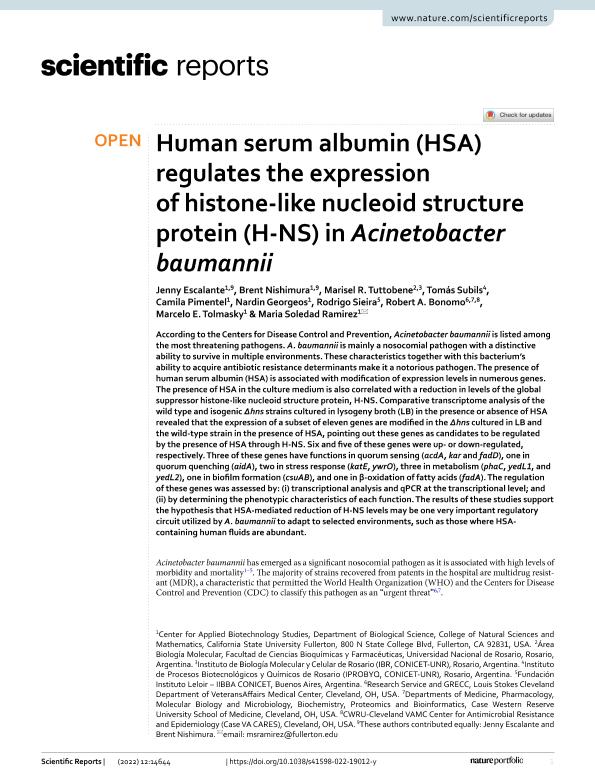Mostrar el registro sencillo del ítem
dc.contributor.author
Escalante, Jenny
dc.contributor.author
Nishimura, Brent
dc.contributor.author
Tuttobene, Marisel Romina

dc.contributor.author
Subils, Tomás

dc.contributor.author
Pimentel, Camila
dc.contributor.author
Georgeos, Nardin
dc.contributor.author
Sieira, Rodrigo

dc.contributor.author
Bonomo, Robert A.
dc.contributor.author
Tolmasky, Marcelo E.
dc.contributor.author
Ramirez, Maria Soledad
dc.date.available
2023-10-02T12:46:07Z
dc.date.issued
2022-08
dc.identifier.citation
Escalante, Jenny; Nishimura, Brent; Tuttobene, Marisel Romina; Subils, Tomás; Pimentel, Camila; et al.; Human serum albumin (HSA) regulates the expression of histone-like nucleoid structure protein (H-NS) in Acinetobacter baumannii; Nature; Scientific Reports; 12; 1; 8-2022; 1-9
dc.identifier.issn
2045-2322
dc.identifier.uri
http://hdl.handle.net/11336/213722
dc.description.abstract
According to the Centers for Disease Control and Prevention, Acinetobacter baumannii is listed among the most threatening pathogens. A. baumannii is mainly a nosocomial pathogen with a distinctive ability to survive in multiple environments. These characteristics together with this bacterium’s ability to acquire antibiotic resistance determinants make it a notorious pathogen. The presence of human serum albumin (HSA) is associated with modification of expression levels in numerous genes. The presence of HSA in the culture medium is also correlated with a reduction in levels of the global suppressor histone-like nucleoid structure protein, H-NS. Comparative transcriptome analysis of the wild type and isogenic Δhns strains cultured in lysogeny broth (LB) in the presence or absence of HSA revealed that the expression of a subset of eleven genes are modified in the Δhns cultured in LB and the wild-type strain in the presence of HSA, pointing out these genes as candidates to be regulated by the presence of HSA through H-NS. Six and five of these genes were up- or down-regulated, respectively. Three of these genes have functions in quorum sensing (acdA, kar and fadD), one in quorum quenching (aidA), two in stress response (katE, ywrO), three in metabolism (phaC, yedL1, and yedL2), one in biofilm formation (csuAB), and one in β-oxidation of fatty acids (fadA). The regulation of these genes was assessed by: (i) transcriptional analysis and qPCR at the transcriptional level; and (ii) by determining the phenotypic characteristics of each function. The results of these studies support the hypothesis that HSA-mediated reduction of H-NS levels may be one very important regulatory circuit utilized by A. baumannii to adapt to selected environments, such as those where HSA-containing human fluids are abundant.
dc.format
application/pdf
dc.language.iso
eng
dc.publisher
Nature

dc.rights
info:eu-repo/semantics/openAccess
dc.rights.uri
https://creativecommons.org/licenses/by/2.5/ar/
dc.subject
ACINETOBACTER BAUMANNII
dc.subject
HUMAN SERUM ALBUMIN
dc.subject
HISTONE-LIKE NUCLEOID
dc.subject.classification
Biología Celular, Microbiología

dc.subject.classification
Ciencias Biológicas

dc.subject.classification
CIENCIAS NATURALES Y EXACTAS

dc.title
Human serum albumin (HSA) regulates the expression of histone-like nucleoid structure protein (H-NS) in Acinetobacter baumannii
dc.type
info:eu-repo/semantics/article
dc.type
info:ar-repo/semantics/artículo
dc.type
info:eu-repo/semantics/publishedVersion
dc.date.updated
2023-07-07T19:49:22Z
dc.journal.volume
12
dc.journal.number
1
dc.journal.pagination
1-9
dc.journal.pais
Reino Unido

dc.description.fil
Fil: Escalante, Jenny. California State University; Estados Unidos
dc.description.fil
Fil: Nishimura, Brent. California State University; Estados Unidos
dc.description.fil
Fil: Tuttobene, Marisel Romina. Consejo Nacional de Investigaciones Científicas y Técnicas. Centro Científico Tecnológico Conicet - Rosario. Instituto de Biología Molecular y Celular de Rosario. Universidad Nacional de Rosario. Facultad de Ciencias Bioquímicas y Farmacéuticas. Instituto de Biología Molecular y Celular de Rosario; Argentina
dc.description.fil
Fil: Subils, Tomás. Consejo Nacional de Investigaciones Científicas y Técnicas. Centro Científico Tecnológico Conicet - Rosario. Instituto de Procesos Biotecnológicos y Químicos Rosario. Universidad Nacional de Rosario. Facultad de Ciencias Bioquímicas y Farmacéuticas. Instituto de Procesos Biotecnológicos y Químicos Rosario; Argentina
dc.description.fil
Fil: Pimentel, Camila. California State University; Estados Unidos
dc.description.fil
Fil: Georgeos, Nardin. California State University; Estados Unidos
dc.description.fil
Fil: Sieira, Rodrigo. Consejo Nacional de Investigaciones Científicas y Técnicas. Oficina de Coordinación Administrativa Parque Centenario. Instituto de Investigaciones Bioquímicas de Buenos Aires. Fundación Instituto Leloir. Instituto de Investigaciones Bioquímicas de Buenos Aires; Argentina
dc.description.fil
Fil: Bonomo, Robert A.. Case Western Reserve University School of Medicine; Estados Unidos
dc.description.fil
Fil: Tolmasky, Marcelo E.. California State University; Estados Unidos
dc.description.fil
Fil: Ramirez, Maria Soledad. California State University; Estados Unidos
dc.journal.title
Scientific Reports
dc.relation.alternativeid
info:eu-repo/semantics/altIdentifier/url/https://www.nature.com/articles/s41598-022-19012-y
dc.relation.alternativeid
info:eu-repo/semantics/altIdentifier/doi/http://dx.doi.org/10.1038/s41598-022-19012-y
Archivos asociados
